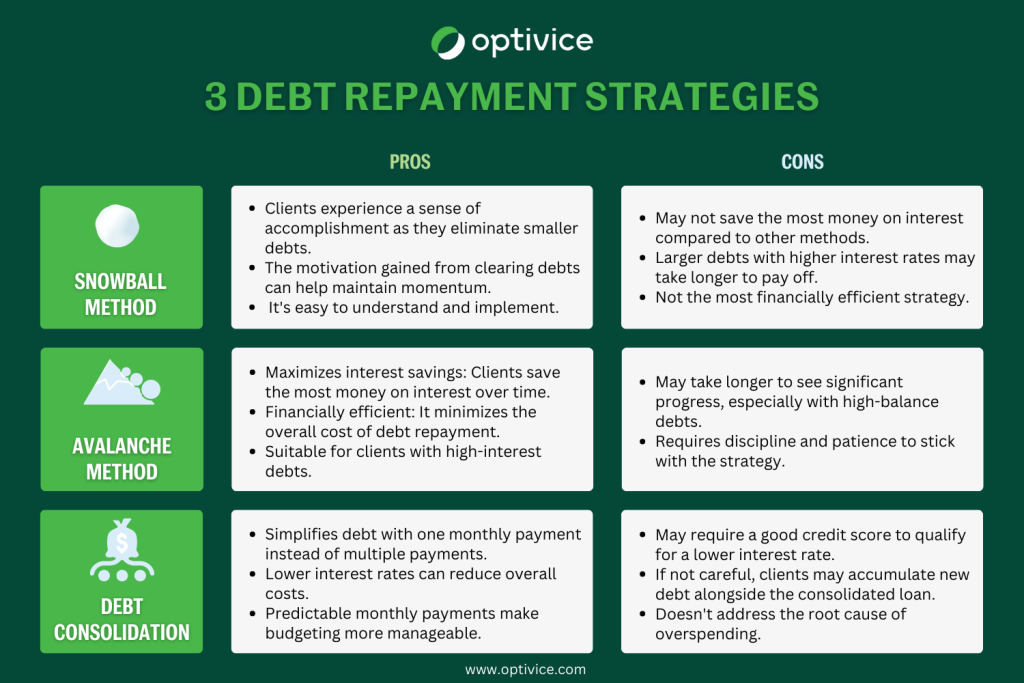Debt can be a significant burden for many individuals and families. Fortunately, financial advisors can provide valuable debt management services and implement various strategies to help their clients effectively manage debt while working towards financial wellness and wealth building. In this blog post, we’ll answer the question “what are the 3 biggest strategies for paying down debt?”, and as a bonus, we’ll introduce a fourth strategy. We’ll examine each strategies pros and cons, and which clients they are best suited for.
What are the 3 Biggest Strategies for Paying Down Debt?
Before we dive in, here is a high-level overview of the three popular debt repayment strategies used by financial advisors to help their clients pay down debt:
- Debt Snowball Method – paying down the smallest debt first
- Debt Avalanche Method – paying down the most expensive debt first
- Debt Consolidation Method – combining multiple high-interests debts into one low-interest debt
1. Debt Snowball Method
The Debt Snowball Method involves paying off debts starting with the smallest balance first, while making minimum payments on larger debts. As each debt is paid off, the money previously allocated to it is redirected toward the next smallest debt – eventually working it’s way up to paying down larger debts.
Pros:
- Quick wins: Clients experience a sense of accomplishment as they eliminate smaller debts.
- Psychological boost: The motivation gained from clearing debts can help maintain momentum.
- Simplicity: It’s easy to understand and implement.
Cons:
- May not save the most money on interest compared to other methods.
- Larger debts with higher interest rates may take longer to pay off.
- Not the most financially efficient strategy.
Best for: The Debt Snowball Method is best for clients who feel overwhelmed by the idea of paying off debt and may need a psychological boost to stay motivated. It’s suitable for those with multiple smaller debts and may not be ideal for those with high-interest debts they want to tackle first.
Example 1: Debt Snowball Method
Joanne has the following debts:
Credit Card A: $2,000 at 18% interest with a minimum payment of $50.
Credit Card B: $5,000 at 22% interest with a minimum payment of $100.
Personal Loan: $10,000 at 12% interest with a minimum payment of $200.
Joanne chooses the Debt Snowball Method. They focus on paying off Credit Card A first, as it has the smallest balance. Their budget allows them to allocate an extra $200 per month towards debt repayment. So, instead of making the minimum $50 payment, they pay $250 toward Credit Card A.
Once that credit card is paid off, they will move onto Credit Card B. At this point, they will be able to use the $250 that is no longer needed to pay of Credit Card A and allocate it to Credit Card B. Therefore, instead of paying the minimum $100 per month, they will be paying $350 towards credit card B while making the minimum payments on their personal loan.
2. Debt Avalanche Method
The Debt Avalanche Method focuses on paying off the debt with the highest interest rate first. Clients make minimum payments on lower-interest debts while aggressively tackling the most costly one.
Pros:
- Maximizes interest savings: Clients save the most money on interest over time.
- Financially efficient: It minimizes the overall cost of debt repayment.
- Suitable for clients with high-interest debts.
Cons:
- May take longer to see significant progress, especially with high-balance debts.
- Requires discipline and patience to stick with the strategy.
Best for: The Debt Avalanche Method is ideal for clients who are financially disciplined and want to minimize the long-term cost of their debts. It’s particularly effective for those with high-interest debts, such as credit card balances.
Example 2: Debt Avalanche Method
Jacob has the same debts as Joanne but decides to use the Debt Avalanche Method.
Jacob targets the debt with the highest interest rate first, which is Credit Card B with a 22% interest rate. They continue making the minimum payments on Credit Card A and the personal loan while allocating extra funds toward Credit Card B.
Once they manage to pay off Credit Card B, which was incurring the highest interest, they will then shift their focus to Credit Card A.
3. Debt Consolidation Method
Consolidating debt involves combining multiple high-interest debts into a single loan with a lower interest rate. This simplifies debt management, reduces interest costs, and streamlines payments.
Pros:
- Simplified debt management: Clients make a single monthly payment instead of multiple payments.
- Lower interest rates: This can reduce overall interest costs.
- Easier budgeting: Predictable monthly payments make budgeting more manageable.
Cons:
- May require a good credit score to qualify for a lower interest rate.
- If not careful, clients may accumulate new debt alongside the consolidated loan.
- Doesn’t address the root cause of overspending.
Best for: Consolidation loans are best for clients with multiple high-interest debts and a good credit score. It’s suitable for those who are committed to not accruing more debt after consolidation.
Bonus Method: High Credit Utilization
Beyond the three main strategies for debt repayment, focusing on high credit utilization is another effective debt repayment strategy. This approach involves targeting and paying off high-credit-utilization accounts first. High credit utilization can negatively impact credit scores, making it harder to secure favorable terms on new loans or credit.
Pros:
- Improves credit score: Paying down high-credit-utilization accounts can boost credit scores.
- Opens up better financial opportunities: A higher credit score can lead to lower interest rates on future loans.
- Addresses credit-related challenges alongside debt repayment.
Cons:
- May not be as emotionally satisfying as the Debt Snowball Method.
- It’s essential to manage all debts responsibly, not just those with high credit utilization.
Best for: The High Credit Utilization Strategy is ideal for clients who want to improve their credit scores while tackling debt. It’s especially valuable if they anticipate needing good credit in the near future, such as when applying for a mortgage or car loan.
Takeaway
Each of these debt repayment strategies has its own strengths and weaknesses. The Debt Snowball Method provides quick wins and motivation but may not be the most financially efficient. The Debt Avalanche Method is ideal for those looking to minimize interest costs over time. Consolidation loans simplify debt management and lower interest rates but require responsible financial behavior.
The best strategy for your clients will depend on their unique financial situations, goals, and personalities. Financial advisors should carefully assess these factors and tailor their recommendations accordingly. Ultimately, the key to success with any debt repayment strategy is discipline, commitment, and a long-term focus on achieving financial freedom.
Want to manage your clients debt more effectively?
Book a Call with our team to learn how Optivice allows you to provide expert debt management services.





